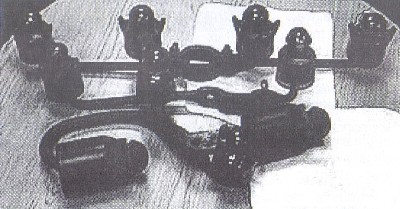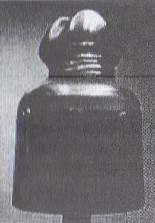Isolateur de Marseilles
by Michael "Polecat" Doyle
Reprinted from "Crown Jewels of the Wire", March 1999, page 68
We felt a gentle nudge shiver through Saipan's hull as the brightly colored
harbor tugs with their grumbling diesels churned out the salt water froth and
urged our 40,000 ton warship closer to its awaiting berth in Marseilles, France.
The shrill of the Boatswain's pipe echoed through the ship's passages and
conversation ceased in anticipation of the announcement "Moored, shift
colors!" At once, fulfillment of Naval tradition and a signal for all line
handlers to take up slack and double up on all mooring lines. Signalmen hurried
up ladders to the O8 level to retrieve the United States Ensign from its
customary station aloft the after mast and carry it, in respectful formation, to
the flag staff specially rigged on the fantail. Engineers repeated their age-old
struggle with hot, tired machinery securing the two three-story tall boilers. In
the Chief Petty Officer's Mess, the USS Saipan Insulator Hunting Team made ready
their gear for yet another foray into exciting, unfamiliar territory. Unfamiliar
and old.

Not old like most Americans think of old, but ancient, thousands of
years old. So old that the word 'antiques' doesn't even exist in some European
languages. Their word antiquities refers to relics fabricated by artisans who
flourished in Mediterranean society thousands of years ago. Greek Sailors from
Phocea, one such civilization in Asia-Minor, first established the sea port of
Massalia near the river Rhone. That picturesque commercial cross-roads that we
call Marseilles today is at least 2600 years old. In comparison, the relative
age of harnessed electricity and communication equipment seems insignificant,
like yesterday. So, with that thought, my shipmates and I set about the 'simple'
task of finding yesterday's insulators in metropolitan Marseilles.
During the first two bright Mediterranean summer days of liberty, Mike Warner
and I stomped and tromped around in the industrial area just outside one of the
many shipyard gates pulling date nails and finding some old glass bottles from
around the turn of the century. In the course of our search we realized that you
had to look carefully at every nook and cranny because the old, paint splattered
insulators seemed to hide In the woodwork.
While we searched the eaves around a
few dockside warehouses and strained to catch a glimpse of glass peeking through
the gloomy soot stained shadows underneath an old railroad bridge, I reflected
back on a past visit where I had seen a red-amber CD 559.2 half-buried In gleaming
white Italian stucco high on the side of an old hotel in Genova, and an ice-green T-bar peeking out from below a 16th century French balcony overlooking
a lush private garden in Toulon. I'd often wondered how easily I might have
obtained those choice pieces had I been able to speak the language....
When
Mike spotted the first rack of gingerbread men under the bridge he let out a
holler that jerked me out of my reverie, and I ran through the tunnels murky
shadows to see what all his excitement was about. Just inside the far end of
tile railroad bridge there were two big green unembossed gingerbread men resting
on a loosely hanging rack mount just ten feet up on tile rock wall. It looked as
though our reconnaissance was going to be an eventful one.

Mike Warner and two gingerbread boys!
Since we had planned our outing as a reconnaissance, we had neither the tools
nor the clothing to support a recovery operation, but we located many desirable
insulators including one light purple jewel in the immediate area that
afternoon. Even though all of the insulators that we saw were no longer in
service, they were still mounted on their iron racks and brackets, they mocked us as we trudged past
them on our way back to the ship where we would consider our day's experience
and formulate a plan to recover them.
As we approached the control point just
outside the dock area, we came to a huge marine engine machine shop with three
sets of four CD 640 gingerbread boys mounted securely to vertical galvanized
steel posts along its roof edge. Since the insulators were not in service, Mike
and I decided that it wouldn't hurt to ask for permission to climb and recover a
set of the little green jewels. We walked into the busy shop where we saw
pistons the size of small trash cans and fuel injector nozzles you could spray
marbles through. Almost immediately we were met by the shop foreman, a wiry old
mechanic clad in oil streaked coveralls who wore an expression of tired
amusement. After exchanging what little French greetings Mike and I were capable
of, we began to explain our request to the foreman. The man spoke just enough
English to understand our request after we walked him outside and pointed out
our objective.
With his permission and a nice big pipe wrench that he said would
make the job easier and faster, we hustled outside to a corner where I boosted
Mike up and he began loosening bolts. Mike had the whole rack down and was back
on the ground in sixteen seconds! We walked back to the door where we found our
benefactor waiting, thanked him profusely, and returned his well worn but highly
effective pipe wrench. With gingerbread boys in hand, we headed once again for
the dockyard gate and beyond toward 'home'.

Once onboard, we headed straight to the Chief Petty Officer's quarters where
we carefully washed each of the four green ISOREX gingerbread boys hoping that
the cleaning would not reveal any hidden damage. That is when I noticed that
there was a difference in their embossing. While one insulator bore the well
known 'ISOREX' lettering, all the others sported a weird half-backward embossing
that read 'XEROSI' where the 'E' was embossed backward but the 'R' and 'S' were
not, which made the embossing impossible to read properly even with a mirror.
The letter sizes varied a bit and the 'I' was slightly out of alignment.
As soon
as I saw the embossing variation I figured that there was no listing for it in
Marilyn Albers' book, GIFONA, and I knew that we had an interesting find; so I
headed straight for the computer to email Marilyn and get the definitive word.
Sure enough, her email reply confirmed what I suspected, we had an unreported
embossing variation for the CD 640 ISO REX gingerbread boy. What an exciting
way to end a great day of insulator hunting!

Light purple CD 545
Over the next couple of days the
Saipan Insulator Hunting Team recovered nine more out-of-service insulators
around the industrial area of Marseilles. Almost every one was in great
condition and each came attached to its iron bracket.
In all, we recovered two CD 642 gingerbread men, six CD 640 gingerbread boys and
one light purple CD 545. A pretty good showing for three day's hunting. By that
time though, I was already looking forward to our next Insulator hunt in and
around Rota, Spain.
| 